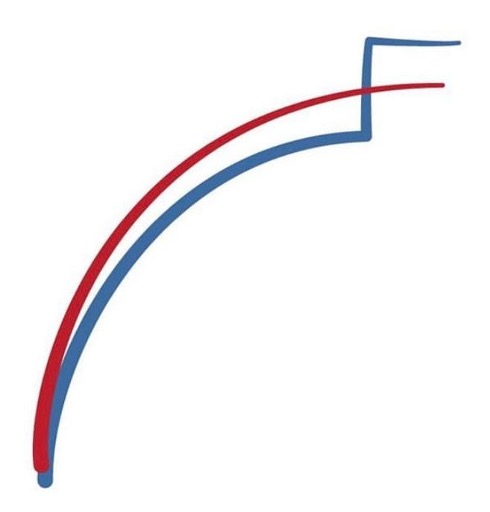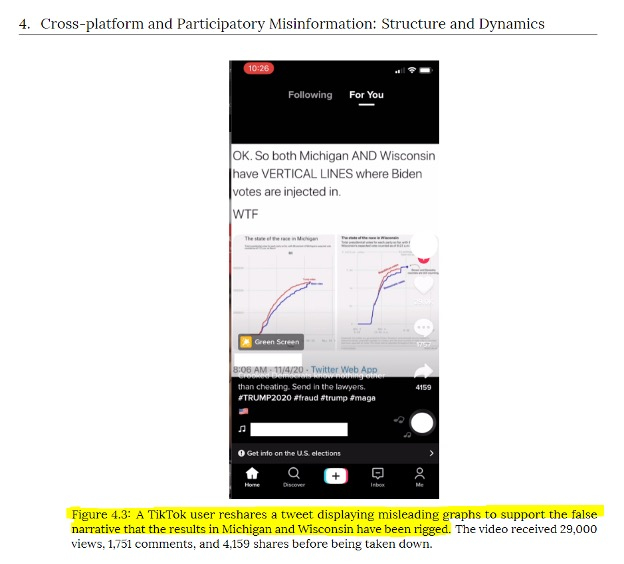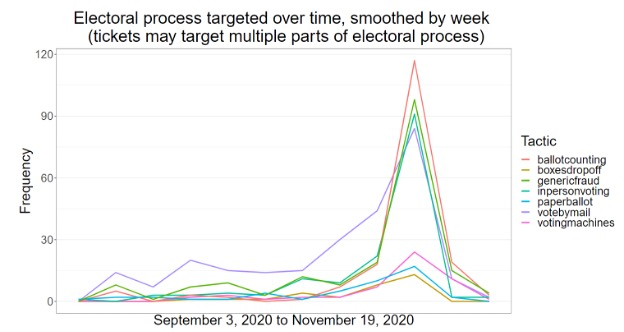In the summer of 2020, the Cybersecurity and Infrastructure Security Agency (CISA) inside the Department of Homeland Security (DHS) pre-declared mail-in ballots to be a “safe and reliable” form of voting, and CISA embarked on a months-long campaign on pre-censor all social media chatter ahead of election day that might cause “delegitimization” of a forthcoming “Red Mirage, Blue Shift” voting sequence.
“Red Mirage, Blue Shift” refers to the scenario where a GOP candidate appears to win on election day, but then due to a late influx of mass mail-in ballots, a DNC candidate appears to suddenly take the lead and win.
It looks like this:

Media pundits presaged these ballot patterns with eyebrow-raising accuracy. “This Election Night could mark the beginning, not the end, of the process, and giving voters a false sense of who is winning, according to a wide array of experts,” reported CNN, two months before the 2020 election. “Early vote counts in the most competitive, battleground states can be particularly misleading this election because of the surge in mail-in or absentee ballots, and the different ways that they are processed,” warned Reuters, a few weeks before the election.
In 2021, the DHS-spawned Election Integrity Partnership released a report titled The Long Fuse: Misinformation and the 2020 Election. The report, nearly 300 pages long, details the partnership’s activities in the 2020 election, setting up a dashboard that allowed the Department of Homeland Security and the State Department to file “tickets” on social media posts, flagging them so that Big Tech platforms could suppress or add warning labels to them. By the EIP’s own estimation, over 22 million tweets were labeled “misinformation” as a result of its activities.
Of particular concern to the EIP were images that depicted the “red mirage, blue shift” pattern. It seems, from its report, that the partnership was aware of pre-election predictions that mail-in ballots would lead to a glut of extra Biden votes at the ballot box:
Changes to voting procedures due to COVID-19 led to expert predictions that more mail-in voting would take place in 2020 than ever before—and that mail-in voting would skew heavily Democrat. Many election analysts predicted that this would lead to an initial “red mirage” followed by a“ blue wave” in some states: the Democratic share (or proportion) of the vote would increase substantially between early counts from day-of voting and final ballot totals, as mail-in ballots were processed. In the weeks leading up to the election, analysts hypothesized about which states would see a large blue shift, which would see minimal shifts, and which might even go in reverse.
The EIP was also aware ahead of the election that the predicted “red mirage, blue shift” was a hot topic of discussion among “right leaning” commentators.
Some right-leaning influencers and communities attempted to frame these predicted shifts as preemptive evidence of a “stolen election” in two ways. First, they pushed a false but largely non-conspiratorial narrative that mass aggregate mail-in ballot fraud by individuals would be responsible for any shift. Second, some offered a set of false, conspiratorial claims that there would be “ballot stuffing” on Election Day, asserting that there would be a systematic, coordinated effort by local authorities to alter the election night vote via the addition of forged ballots or the swapping of “real” ballots for fake ones.
Even before the election, therefore, the censorship industry was gearing up to suppress discussion of the “red mirage, blue shift” phenomenon. In its report, the EIP expressed concern that images of the ballot counting pattern were attracting tens of thousands of views on some social media platforms before eventually being censored.
From the report:

The EIP report brands the images “misleading,” despite the fact that they depict actual election voting patterns.
The report is also interesting because it makes no attempt to conceal the EIP’s origins in the Department of Homeland Security’s sub-agency, the Cybersecurity and Infrastructure Security Agency. Nor did it conceal the purpose of the EIP: to monitor and suppress domestic political speech that government agencies are constitutionally forbidden from interfering with directly.
In the EIP’s entire 292-page report, there is only one use of the term “First Amendment” that isn’t a footnote. It appears in a section explaining that the EIP was in part set up because the constitution forbids the government from from taking “law enforcement” action against alleged “misinformation.”
From the report:
The initial idea for the Partnership came from four students that the Stanford Internet Observatory(SIO) funded to complete volunteer internships at the Cybersecurity and Infrastructure Security Agency(CISA) at the Department of Homeland Security. Responsibility for election information security is divided across government offices: CISA has authority to coordinate on cybersecurity issues related to the election, the FBI to investigate cyber incidents and enforce election laws, and intelligence agencies to monitor for foreign interference. Yet, no government agency in the United States has the explicit mandate to monitor and correct election mis-and disinformation. This is especially true for election disinformation that originates from within the United States, which would likely be excluded from law enforcement action under the First Amendment and not appropriate for study by intelligence agencies restricted from operating inside the United States. As a result, during the 2020 election, local and state election officials, who had a strong partner on election-system and overall cybersecurity efforts in CISA, were without a clearing house for assessing mis- and disinformation targeting their voting operations. The students approached SIO leadership in the early summer, and, in consultation with CISA and other stakeholders, a coalition was assembled with like-minded partner institutions.
This is something that Alex Stamos, a former Facebook executive and one of EIP’s founding members, admitted in a livestream: that the EIP was set up “to try to fill the gap of the things that the government could not do themselves” because the government “lacked both kinda the funding and the legal authorizations.”
A less charitable way of saying “lacked the legal authorizations” is “illegal” – or at least legally dubious.
From the very beginning, this government-linked partnership, created to do things the government was legally prohibited from doing, had a laser focus on censoring domestic speech about election processes.
A graph in the EIP’s report shows that throughout the months leading up to the election, its censorship apparatus was intensely focused on discussion around ballot counting, vote by mail, voting machines, and other election-related topics.

At the state level, the highest number of tickets to censor “misinformation” were related to Pennsylvania, which was also the state that had the greatest amount of mail-in ballots to count after election day.

Michael Benz is the Executive Director of the Foundation for Freedom Online. Previously, Mr. Benz served as Deputy Assistant Secretary for International Communications and Information Technology at the U.S. Department of State. Follow him on Twitter @FFO_Freedom.




